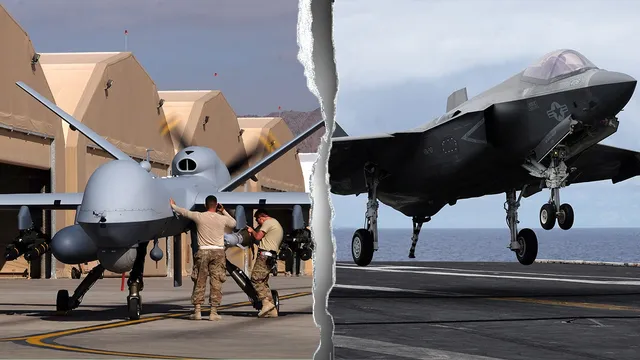
Military debates future of manned versus unmanned fighter jets
2025-07-02 08:00- Military strategists in the US are questioning the necessity of manned fighter jets due to technological advancements.
- Debates revolve around the effectiveness and safety of unmanned drones compared to human pilots.
- The discussion highlights the evolving nature of pilot training and military operations in future combat scenarios.
Express your sentiment!
Insights
In the United States, military strategists and officials are increasingly questioning the necessity of manned aircraft in air combat as advancements in technology evolve. The discussion is fueled by concerns over pilot safety, particularly as advanced drones can potentially serve as effective replacements for human pilots. Some experts argue that the F-35 should be the last manned aircraft, urging the military to embrace unmanned platforms fully by 2050. There are divided opinions among defense officials regarding the current capabilities and limitations of unmanned technology in combat scenarios, which leads to an ongoing evaluation of air combat strategies. The recent B-2 bomber missions to Iran, praised for their destructive accuracy against nuclear facilities, have heightened the debate surrounding the use of manned aircraft. Retired military officials and analysts express skepticism about manned platforms, stating, “Why would we put men in that loop?” They suggest that as technology progresses, an efficient unmanned system could execute similar missions effectively without the risk to human life. However, other defense experts emphasize that there are still unique benefits to having pilots in the cockpit. Aircrews have valuable situational awareness and decision-making abilities that remote-operated systems currently cannot replicate. They play a critical role in orchestrating combat operations, acting like a quarterback to manage unmanned flights alongside traditional forces. Boeing has been urged to accelerate its development of new aircraft platforms to keep pace with these advancements while ensuring manned capabilities are maintained for the foreseeable future. Additionally, as the Air Force and Navy take different approaches towards integrating unmanned technology into their fleets, there seems to be a lack of consensus on the timeline for fully uncrewed tactical air capabilities. Experts warn that meaningful outcomes from these strategic changes may take several years, highlighting the need for continuous evaluation of the military's air power structure. The evolving landscape of pilot education is also adapting, with companies like Red 6 pioneering augmented and mixed reality technologies to enhance training, ensuring pilots are adequately prepared for future confrontations in an increasingly automated environment.
Contexts
The impact of AI on military aviation has been profound, fundamentally transforming the way air forces operate in the modern battlefield. With the increasing complexity of warfare, the integration of artificial intelligence (AI) technologies into military aviation systems has enhanced decision-making processes, improved operational efficiency, and expanded capabilities that were previously unattainable. AI applications range from autonomous combat drones to advanced data analytics for mission planning, benefiting military strategists and operators by providing real-time insights and predictive capabilities that enable faster, more informed decisions. This shift towards AI-driven operations not only increases mission effectiveness but also offers enhanced safety for personnel by reducing the risk associated with manned aircraft missions. As nations around the globe continue to invest heavily in AI research, maintaining a technological edge in military aviation has become imperative. AI applications in military aviation can be divided into several key areas, including autonomous systems, predictive maintenance, and enhanced training simulations. Autonomous drones and aircraft are being developed to perform reconnaissance, surveillance, and even combat missions with minimal human intervention, thereby reducing the cognitive load on pilots and allowing them to focus on more complex tasks. Meanwhile, predictive maintenance leveraging AI can analyze data collected from aircraft systems to anticipate potential failures before they occur, thus extending the lifespan of significant military assets and reducing downtime. Moreover, advanced AI-powered simulations offer military pilots and crew the opportunity to train in highly realistic environments, allowing them to hone their skills and prepare for diverse scenarios without the cost and risk associated with live training exercises. Despite the advantages AI brings to military aviation, there are also significant challenges and concerns that must be addressed. The ethical implications of using AI in warfare are of paramount importance, raising questions about accountability, decision-making authority, and the potential for unintended consequences. Ensuring that AI systems operate within the framework of international law and ethical standards is critical as militaries explore the use of autonomous weapons. Additionally, the increasing reliance on AI technologies raises concerns about cybersecurity; adversaries may attempt to exploit vulnerabilities within AI systems, leading to potential breaches or manipulation that could compromise military operations or safety. Therefore, it is crucial for military organizations to develop robust cybersecurity measures and regulatory frameworks to manage the risks associated with AI integration into aviation. In conclusion, the ongoing evolution of artificial intelligence will undeniably continue to shape the future of military aviation. As air forces adopt AI tools and technologies, they will gain a strategic advantage in terms of operational capabilities and efficiency. However, addressing the ethical dilemmas and cybersecurity challenges that accompany this technological shift will be vital to ensuring that AI's contributions enhance military aviation and do not lead to unforeseen negative consequences. Policymakers and military leaders must work together to strike a balance between harnessing AI for operational superiority and maintaining a commitment to responsible and safe military practices.